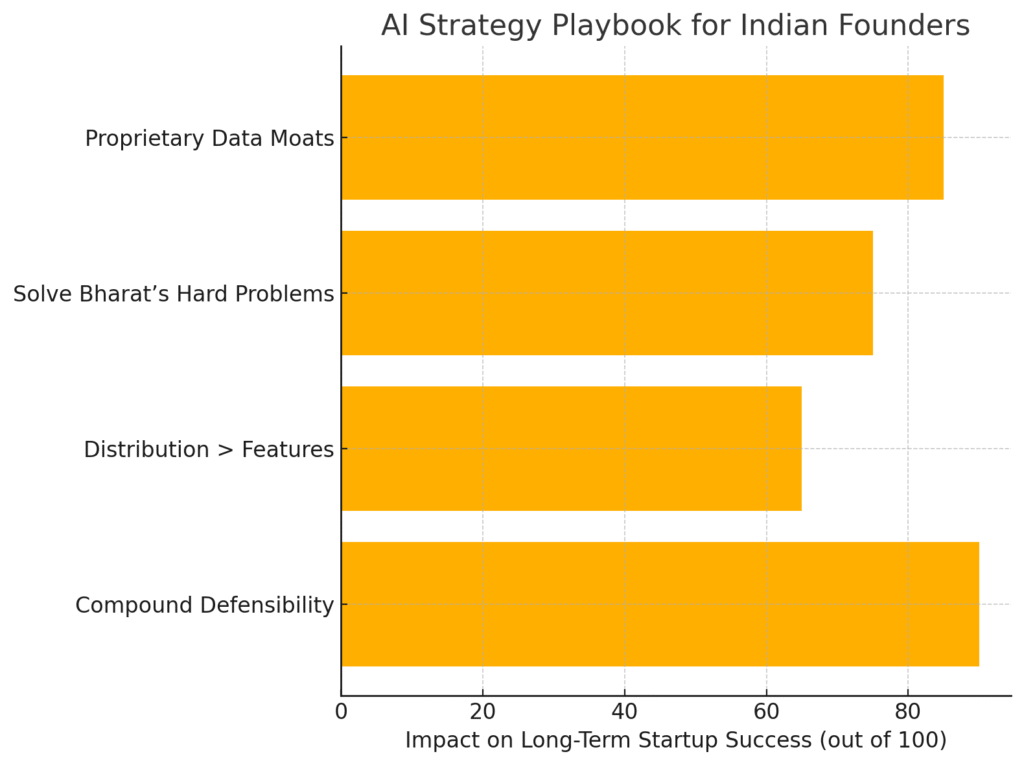Table Of Content
- The Fork in the Road
- The Great AI Rush in India
- Where AI Is Genuinely Creating Value
- The Copycat Crisis: ChatGPT Wrappers Everywhere
- What Founders Should Do Differently
- 1. Build Proprietary Data Moats
- 2. Solve Bharat’s Hard Problems
- 3. Distribution > Features
- 4. Compound Defensibility
- Contrarian Take: AI Is a Trap for Lazy Founders
- Visual: AI in Indian Startups – Copycats vs. Smart Innovators
- Conclusion: From Hype to Legacy
- FAQs
The Fork in the Road
Artificial Intelligence is the new currency of credibility in India’s startup scene. Founders sprinkle “AI-powered” across pitch decks, investors nod eagerly, and every week a new “ChatGPT for X” clone pops up.
But here’s the contrarian truth: AI is not making Indian startups smarter—it’s making them faster copycats.
At least, that’s the danger if founders treat AI as a shiny wrapper rather than a deep moat. The real opportunity lies not in copying Silicon Valley’s playbooks but in solving India-specific problems with originality, proprietary data, and defensibility.
The Great AI Rush in India
Between 2020 and 2025, India saw an 11x surge in AI-tagged startups, according to Tracxn. But peel back the layers, and over 60% of these “AI startups” rely on plug-and-play APIs from OpenAI, Google, or Anthropic.
That means:
- Speed? Yes. Launch an AI startup in a week.
- Originality? Rare. If a thousand others can copy you overnight, what’s the moat?
This mirrors the dot-com bubble: plenty of logos, but few lasting models.
Where AI Is Genuinely Creating Value
It would be unfair to say AI in India is all hype. In some sectors, AI is truly a force multiplier:
| Sector | Example Startups | AI Advantage | Impact |
|---|---|---|---|
| AgriTech | Fasal, CropIn | Predictive irrigation & yield modeling | Reduces input costs for farmers by 10–15% |
| Fintech | KredX, Indus OS | Fraud detection on Indian transaction data | Expands safe lending in Tier 2/3 |
| Healthcare | Qure.ai, SigTuple | AI diagnostics in radiology & pathology | Bridges shortage of medical specialists |
| Logistics | Locus, Delhivery | AI-driven route optimization | Reduces last-mile costs by up to 20% |
These examples show where AI isn’t just a buzzword but contextually powerful in India’s unique environment.
The Copycat Crisis: ChatGPT Wrappers Everywhere
For every success story, there are dozens of “copycat wrappers”:
- “AI resume builder” = GPT with a UI.
- “AI learning assistant” = ChatGPT with custom prompts.
- “AI customer support” = same API, different brand.
These startups scale fast, but they’re feature, not product. Once Google or OpenAI add that feature, the startup’s edge vanishes.
Investors have caught on. Bain’s India VC Outlook 2025 warns: “AI claims without proprietary data or defensibility will not attract late-stage funding.”
“Just as building an early community gives startups an unfair edge, AI defensibility also depends on owning the right distribution and data channels.”
What Founders Should Do Differently

If you’re an Indian founder, here’s the smarter AI playbook:
1. Build Proprietary Data Moats
- Train models on Indian languages (Hindi, Tamil, Odia, Bhojpuri).
- Collect transactional, behavioral, and agricultural data unavailable globally.
2. Solve Bharat’s Hard Problems
Forget copying Silicon Valley’s productivity tools. Focus on India’s high-friction sectors: agriculture, logistics, MSME financing, rural health.
3. Distribution > Features
AI features can be cloned. A strong distribution channel—community-led growth, rural partnerships, integrations with government schemes—creates real stickiness.
4. Compound Defensibility
Think in decades. Proprietary data + strong distribution = a moat no API clone can touch.
Contrarian Take: AI Is a Trap for Lazy Founders
The seductive part of AI is speed: you can build a flashy demo in hours. But that’s also the trap. Speed without originality only accelerates mediocrity.
The Indian founder who wins in AI won’t be the fastest copier. It’ll be the one who asks:
- What becomes solvable in India only because of AI?
- What’s my defensible edge when the APIs are free for everyone else?
Visual: AI in Indian Startups – Copycats vs. Smart Innovators
| Metric | Copycat Wrappers | Smart Innovators |
|---|---|---|
| Time to Launch | Days | Months/Years |
| Defensibility | None | Proprietary data |
| Funding Sustainability | Low | High |
| Value to Bharat | Cosmetic | Transformative |
Conclusion: From Hype to Legacy
India’s AI revolution is at a fork. One path leads to a graveyard of wrappers, startups that rose fast but were erased just as quickly. The other path leads to smarter, Bharat-first innovation, where AI is not a gimmick but the engine of inclusion and efficiency.
Founders must choose: be a faster copycat, or a smarter original.
FAQs
Because they often repackage global APIs (like OpenAI) with thin layers, offering little defensibility or originality.
Agriculture, healthcare, fintech, and logistics—areas where India’s scale and challenges create unique opportunities.
Yes, but only as features within bigger platforms, not as standalone companies. Long-term success needs moats like data or distribution.
By training on proprietary Indian datasets, solving local problems, and creating distribution networks others can’t replicate.
No. AI is a lever, not a substitute. Founders who combine context + originality + execution will outlast those who rely only on APIs.




